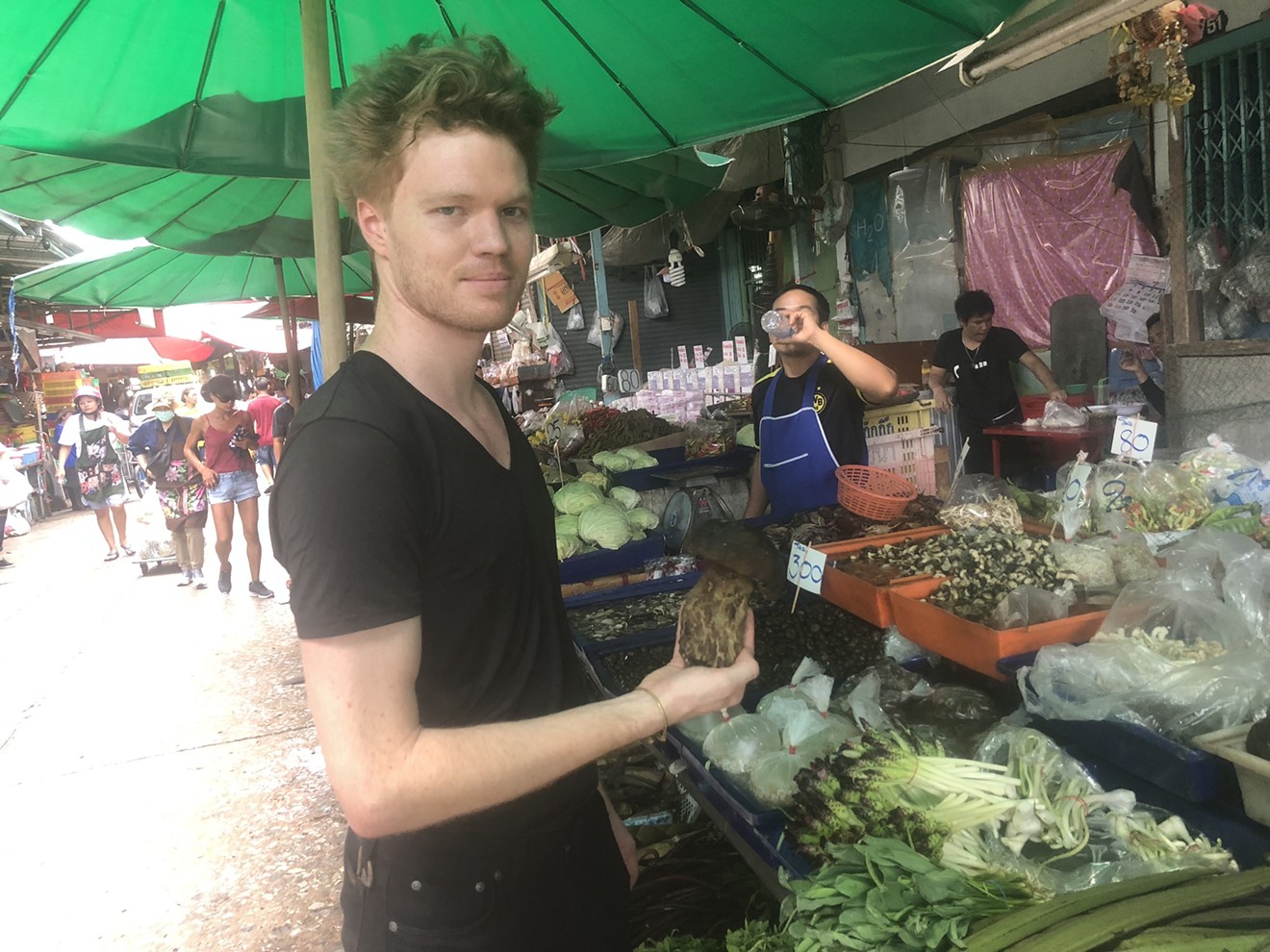“Try this: earthstar mushroom,” says Riley Sanders, chef of Michelin-starred restaurant Canvas in Bangkok.
“These are highly seasonal and must be foraged. You can just eat it raw,” he explains, handing me what looks like a small, smooth, brown rock. I pop it in my mouth and am hit with a burst of earthy, meaty intense umami goodness.
We are at Khlong Toei, Bangkok’s largest outdoor “wet” market (as opposed to durable goods “dry” markets), where the chef comes searching for new flavors and ingredients for his ever-changing menu at the tasting-menu-only restaurant. Because of Thailand's multiple climate zones from north to south, almost everything can be grown here, and as the terminus for farmers and food producers, the markets in Bangkok have an overwhelming diversity of options. Simply strolling through the stalls covered by a hodgepodge of tarps and tin roofs, it would be hard for any cook not to be inspired by the dozens of species of fish and seafood, iced tables piled high with chicken and pork in every primal and off-cut imaginable, and a cornucopia of local fruits and vegetables.
In Thailand, the idea of “locally sourced, organic, farm-to-table and heirloom” is encompassed by a simple and concise term: food. Nearly every prepared food vendor, from the smallest food stall to the swankiest restaurant, shops at the markets, either by sending a member of the kitchen staff or through a Thai “shopper” who can navigate the local sellers and products. There are some delivery options, but rather than a purveyor distributing from a warehouse in a truck, the task is simply performed by a tuk-tuk pulling up in the early-morning hours precariously loaded to the gills with produce. In recent years, however, the proliferation of high-end restaurants like Canvas has created a market that allows for direct deliveries from farmers all over the country, who often travel hundreds of miles overnight and into the early morning to deliver to the city.
For chefs like Sanders, the cuisine becomes more engaging with the “where” rather than the “when” of ingredients, almost the opposite of how chefs are taught to think in the West.
“I'd say what's interesting, specifically in Thailand, is the regionality of the ingredients," the chef explains. "Ingredients used in Issan [in the northeast] are different than what you'd find in the north or south. As a whole, I don't think it's highly seasonal. It is more so in Issan because they're a less developed region and have a history of foraging for products in the forest or jungle. There are three distinct seasons — hot, cool, rainy — and each one has things that will come and go into season for a couple of weeks, a couple of months, or...that carry over across the seasons.”
While the opportunities to discover novel items are abundant, the lack of taxonomy provides another challenge for Westerners like Sanders (a Texas transplant). “There is some difficulty in finding the proper scientific names for ingredients, and it takes significant research to figure out exactly what you have,” he explains. In addition to discoveries from his market trips, he also relies on suggestions and information from his Thai staff about what ingredients are available, and when, for classic Thai preparations of more esoteric finds.
“Depending on the region and dialect, a product could have many different names, and I'm not always sure if similar products are exactly the same," he continues. “Some of my favorite products are long pepper from northern Thailand, mak kwan from Mae Hong Son, malaep from Phrae, taling ping (a sour fruit related to starfruit), hed pop (a wild mushroom found in both Northern Thailand and Issan), dala flower (a torch ginger flower), and ant eggs (typical in Issan). We use them in a variety of techniques — dried, fermented, pickled, preserved in oil, or in pastes and purées, or as a base for seasoning stocks or sauces.”
The system seems complicated to someone accustomed to how most Colorado restaurants get their food. In Bangkok, there's no centralized distribution, nicely refrigerated trucks or purveyors with customer service easily reachable by phone (forget email). But the trade-offs more than compensate for the inconveniences. Farmers grow a variety of crops; they drive them to market. People buy them, cook them and eat them — what's simpler than that?
Ben Whelan is a Denver chef and former instructor at Emily Griffith Technical College's Culinary Quick Start program, where he taught for the last two years before he embarked on a one-year mission to Thailand to work, cook, train and eat everything in his path. Whelan arrived in Bangkok in July 2019 and will be sending dispatches on the cuisine, culture and characters he encounters along the way.
[
{
"name": "Air - MediumRectangle - Inline Content - Mobile Display Size",
"component": "12017618",
"insertPoint": "2",
"requiredCountToDisplay": "2"
},{
"name": "Editor Picks",
"component": "17242653",
"insertPoint": "4",
"requiredCountToDisplay": "1"
},{
"name": "Inline Links",
"component": "18838239",
"insertPoint": "8th",
"startingPoint": 8,
"requiredCountToDisplay": "7",
"maxInsertions": 25
},{
"name": "Air - MediumRectangle - Combo - Inline Content",
"component": "17261320",
"insertPoint": "8th",
"startingPoint": 8,
"requiredCountToDisplay": "7",
"maxInsertions": 25
},{
"name": "Inline Links",
"component": "18838239",
"insertPoint": "8th",
"startingPoint": 12,
"requiredCountToDisplay": "11",
"maxInsertions": 25
},{
"name": "Air - Leaderboard Tower - Combo - Inline Content",
"component": "17261321",
"insertPoint": "8th",
"startingPoint": 12,
"requiredCountToDisplay": "11",
"maxInsertions": 25
}
]















